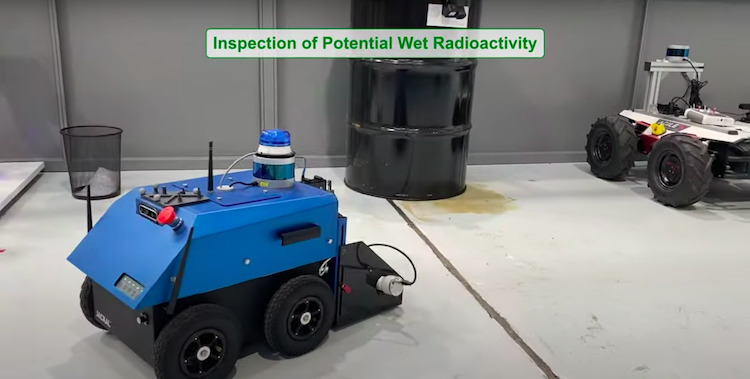
Nuclear decommissioning engineers are testing a Smurf – not one of the little blue people, but a Symbiotic Multi-Robot Fleet (SMuRF).
Engineers from University of Glasgow, University of Manchester, Bristol Robotics Laboratory and Heriot-Watt University are behind the development of the SMuRF system.
It enables wheeled, four-legged and airborne robots to collaborate and complete tasks that could be difficult or harmful for humans to undertake on their own. A single human supervisor can remotely observe the robots’ actions as they share sensor data between themselves, combining their abilities to achieve results far beyond the capability of a single machine.
SMuRFs could offer authorities, regulators and industry a safer, faster method of monitoring nuclear facilities, according to the University of Glasgow. In addition, they offer new opportunities for the maintenance of engineering infrastructure in challenging environments like offshore wind power platforms.
In a paper published in IET Cyber-Systems and Robotics, the researchers outline how they deployed the SMuRF in a practical demonstration at the Robotics and Artificial Intelligence Collaboration facility in Cumbria.
Successful mission
During the demonstration, the SMuRF successfully completed an inspection mission in a simulated radioactive storage facility containing some of the challenges found in real nuclear power decommissioning environments.
The robots’ ability to collaborate is the result of a computer system developed by the researchers, which they call a ‘cyber physical system’, or CPS.
The CPS can communicate with up to 1,600 sensors, robots and other digital and physical assets in near to real-time. It also allows robots with different abilities and operating systems to work together and update the human operator.
The data collected and processed by the CPS enables the creation of a 3D digital twin of a real space. That allows the SMuRF to navigate around the space and carry out tasks with minimal oversight, while providing human operators with a wealth of data via a digital dashboard to help the robots make informed decisions if required. Human operators can also take direct control of the robots if they need to.
Radiation monitoring
Combining the robots’ abilities allowed them to complete a series of tasks often applied to radiation monitoring around nuclear sites known as post-operational cleanout.
The robots collaborated to map the environment, creating a 3D digital twin of the space using their onboard sensors, which was supported by further mapping from an aerial drone piloted by a human operator.
Boston Dynamics’ Spot fetched tools for closer scans using its flexible arm, while wheeled robots Scout and CARMA mapped radiation levels across the testing environment. The CARMA robot successfully detected a simulated spill of radioactive liquid underneath a waste barrel, a result that could help ensure proper containment and cleanup in a real-world environment.
David Flynn, Professor in Cyber Physical Systems at the University of Glasgow, is a co-author of the paper. He said: “The next step for our research is to integrate a wider range of robots in our fleets, with even more diverse abilities to sense their surroundings, move through them in new ways, and manipulate objects.”
Don’t miss out on BIM and digital construction news: sign up to receive the BIMplus newsletter.












